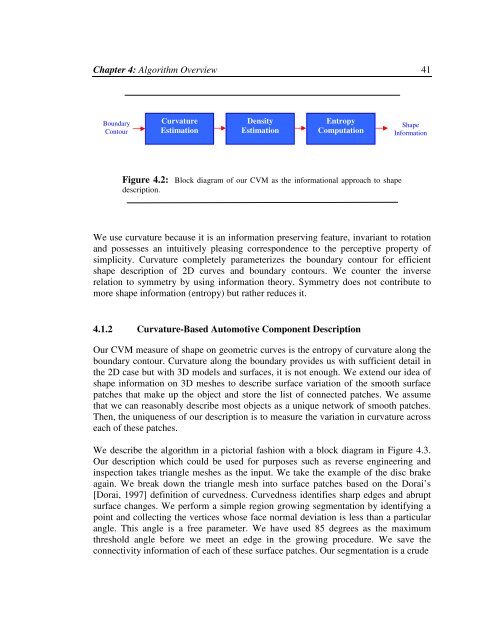To the Graduate Council: I am submitting herewith a thesis written by ...
To the Graduate Council: I am submitting herewith a thesis written by ...
To the Graduate Council: I am submitting herewith a thesis written by ...
Create successful ePaper yourself
Turn your PDF publications into a flip-book with our unique Google optimized e-Paper software.
Chapter 4: Algorithm Overview 41BoundaryContourCurvatureEstimationDensityEstimationEntropyComputationShapeInformationFigure 4.2: Block diagr<strong>am</strong> of our CVM as <strong>the</strong> informational approach to shapedescription.We use curvature because it is an information preserving feature, invariant to rotationand possesses an intuitively pleasing correspondence to <strong>the</strong> perceptive property ofsimplicity. Curvature completely par<strong>am</strong>eterizes <strong>the</strong> boundary contour for efficientshape description of 2D curves and boundary contours. We counter <strong>the</strong> inverserelation to symmetry <strong>by</strong> using information <strong>the</strong>ory. Symmetry does not contribute tomore shape information (entropy) but ra<strong>the</strong>r reduces it.4.1.2 Curvature-Based Automotive Component DescriptionOur CVM measure of shape on geometric curves is <strong>the</strong> entropy of curvature along <strong>the</strong>boundary contour. Curvature along <strong>the</strong> boundary provides us with sufficient detail in<strong>the</strong> 2D case but with 3D models and surfaces, it is not enough. We extend our idea ofshape information on 3D meshes to describe surface variation of <strong>the</strong> smooth surfacepatches that make up <strong>the</strong> object and store <strong>the</strong> list of connected patches. We assumethat we can reasonably describe most objects as a unique network of smooth patches.Then, <strong>the</strong> uniqueness of our description is to measure <strong>the</strong> variation in curvature acrosseach of <strong>the</strong>se patches.We describe <strong>the</strong> algorithm in a pictorial fashion with a block diagr<strong>am</strong> in Figure 4.3.Our description which could be used for purposes such as reverse engineering andinspection takes triangle meshes as <strong>the</strong> input. We take <strong>the</strong> ex<strong>am</strong>ple of <strong>the</strong> disc brakeagain. We break down <strong>the</strong> triangle mesh into surface patches based on <strong>the</strong> Dorai’s[Dorai, 1997] definition of curvedness. Curvedness identifies sharp edges and abruptsurface changes. We perform a simple region growing segmentation <strong>by</strong> identifying apoint and collecting <strong>the</strong> vertices whose face normal deviation is less than a particularangle. This angle is a free par<strong>am</strong>eter. We have used 85 degrees as <strong>the</strong> maximumthreshold angle before we meet an edge in <strong>the</strong> growing procedure. We save <strong>the</strong>connectivity information of each of <strong>the</strong>se surface patches. Our segmentation is a crude
















